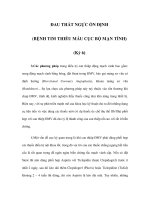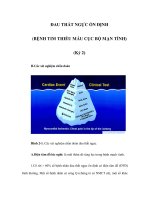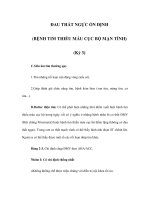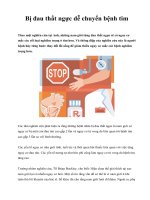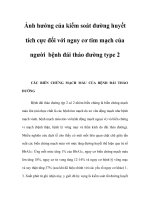Kiểm soát đau thắt ngực và nguy cơ tim mạch nhờ cải thiện chức năng nội mạch
Bạn đang xem bản rút gọn của tài liệu. Xem và tải ngay bản đầy đủ của tài liệu tại đây (2.41 MB, 24 trang )
14th Vietnam National Congress of Cardiology
Da Nang, Vietnam
October 11-14, 2014
Managing Angina and Risk via
Improved Endothelial Function:
The EECP Model
Gregory W. Barsness, MD, FACC, FAHA, FSCAI
Consultant, Internal Medicine & Cardiology and Radiology
Director, Mayo Clinic EECP Laboratory
Director, Mayo Clinic Cardiac Intensive Care Unit
Mayo Clinic College of Medicine
Rochester, MN, USA
Nothing to Disclose Related to this Talk
Endothelial Function
The Importance of Balance
Normal Endothelial Function
NO
ET-1
PGI2
AngII
Vasodilation
Atheroprotective
NO Function
Vasodilatory
Antithrombotic
Antiproliferative
Anti-inflammatory
Endothelial Function
The Importance of Balance
Endothelial Dysfunction
NO
PGI2
ET-1
AngII
↓Endothelial repair
Depletion of EPCs
Vasoconstriction
Atherogenic
Coronary Endothelial Dysfunction
Relationship to Risk Factors
15
10
5
Slope of
0
Ach dose
response
-5
relationship
(% diameter -10
change/log -15
Ach)
-20
-25
-30
r=-0.73
P<0.0001
0
1
2
3
4
5
6
Risk factors (no.)
Vita et al: Circ 81:491, 1990
Coronary Endothelial Dysfunction
Relationship to Ischemia
350
300
Coronary
blood flow
response
(%)
NS
Exercise thallium
Normal
Abnormal
250
400
300
P<0.005
200
200
P<0.01
150
100
100
50
0
0
CTL
AC1
Zeiher, Circulation 1995;91:2345-52.
AC2
AC3
PAPA
Abnormal Peripheral Endothelial Function
Relationship to Cardiac Events
Cardiac death/MI/
revasc/C hosp (%)
60
Endothelial
Dysfunction
40
Normal
Endothelial
Function
20
0
0
1
2
3
4
5
6
7
Years from EndoPAT study
Rubinshtein and Lerman, Euro Heart J 2010
Vulnerability
Smoking
Hypertension
Hypercholesterolemia
New risk
factors
Diabetes
Genomic
predisposition
Endothelial Dysfunction ► The Vulnerable Patient
Dementia
Heart failure
Bonetti et al, ATVB 2003
Stroke
Acute Coronary
syndrome
Sudden death
Naghavi et al, Circulation 2003
Importance of Shear Stress
CTO Revascularization and 7 Mo FollowUp
Shear Stress is Atheroprotective
• Antithrombotic
• Antimigration
• Pro-Survival
Shear Stress is Vasodilatory
ECG-Gated Sequential Diastolic Activation
EECP Enhances Shear Stress Forces
Doppler Ultrasound of Descending Aorta
In aorta (like IABP)
• Improved retrograde
diastolic and
enhanced antegrade
systolic flow
Improved flow
demonstrated in
• Renal arteries
• Carotid arteries
• Internal mammary
arteries
• Coronary arteries
Shear Stress Effect of EECP
Dose-Related NO Increase in Humans
Endothelin-1 (pg/L)
Nitric Oxide (mg/L)
ET-1/NO Ratio
250
200
2.5
*
150
2.0
*
P<0.01
1.5
100
*
50
*
*
th
on
3M
on
th
0.5
1M
EC
P
st
-E
hr
Po
24
-
hr
12
-
r
1h
EE
CP
0
Pr
e-
1.0
*
36 hours of ECP in 13 patients
Ahktar et al, AJC 2006
Reactive Hyperemia-PAT Protocol
Cuff inflation
60 mm > SBP
10 minutes
5 minutes
Occlusion
Cuff
deflation
10 minutes
Quantitation of RH-PAT (RH-PAT index)
Post-occlusion PAT-amplitude
RH-PAT index =
Pre-occlusion PAT-amplitude
EECP Effect on Endothelial Function
RH-PAT During Treatment
p=0.006
RH-PAT index (1 minute)
2.5
p<0.001
2
1.5
1.2
1
0.5
0
Day1
Day17
Pre-EECP
Bonetti, Barsness et al, JACC 2003
Post-EECP
Day35
EECP Effect on Endothelial Function
RH-PAT 1 Month Following Treatment
* p < 0.05 vs. days 1, 17, and 35
1.5
*
RH-PAT index
1.29
1
1.04
1.05
1.04
Day 1
Day 17
Day 35
0.5
0
Pre-EECP
Bonetti, Barsness et al, JACC 2003
1-month
follow-up
Clinical Benefit and RH-PAT Index
CCS Angina Class
* p < 0.05 vs. day 1
RH-PAT index
2
*
1.5
1
1.33
1.02
1.07
1.17
0.5
0
CCS improvement
Day 1
Bonetti, Barsness et al, JACC 2003
No CCS improvement
1-month follow-up
Clinical Benefit and RH-PAT index
Duke Activity Status Index (DASI)
* p < 0.05 vs. day 1
RH-PAT index
2
*
1.5
1.32
1
1.00
1.14
1.24
0.5
0
DASI improvement
Day 1
Bonetti, Barsness et al, JACC 2003
No DASI improvement
1-month follow-up
Relation Between the Number of Endothelial Progenitor Cells
and Endothelial Function
Endothelial progenitor cells
(colony-forming units)
r=-0.59
P<0.001
Change in brachial reactivity (%)
Hill et al: NEJM 348(7):597, 2003
CP1099981-3
Circulating Progenitor Cells After EECP
Flow Cytometric Analysis (FACS)
100
HPC
HPC
HPC
EPC
Cell count/ 100µL Buffy Coat
90
CD34+ CD45dim (p=0.028)
CD133+ CD45dim (p=0.034)
CD34+ CD133+ CD45 dim(p=0.019)
CD34+ CD45 - VEGFR2+ (p=0.17)
80
70
60
50
40
30
20
10
0
Normal
CED
Baseline
Boilson, Kiernan, Barsness, IJC 2011
Day 17
Day 35
(final)
1 month post
treatment
Where do we go from here?
Persistent Endothelial Dysfunction
is Associated with CV Events
Cumulative eventfree probability
1.0
Improved FMD
0.8
Persistently impaired FMD
0.6
0.4
0.2
P<0.01
0.0
0
10
20
30
Months after enrollment
Kitta Y et al: J Am Coll Cardiol 53:323, 2009
CP1343701-4
Interventions that Improve Endothelial
Function and Clinical Outcome
Statins/Low Fat Diet
ACE Inhibitors/ARBs
Calcium Channel Blockers
N-3 Fatty Acids
Glycemic Control in Diabetes
Blood Pressure Lowering
Smoking Cessation
Weight Reduction
Exercise
PDE-5 Inhibitors
Aspirin
EECP
The Bottom Line
Optimal
medical therapy and risk factor
modification are essential to improve
endothelial function and outcome
Exercise and EECP provide safe,
effective, durable symptom relief:
Improved QoL and vascular health
Potential pathway to improve prognosis via
plaque modification, vascular function and
myocardial performance effects (improved
systolic and diastolic functional parameters)
Mayo Clinic
Rochester, MN, USA
CP1124540-1




